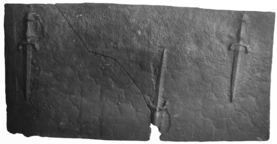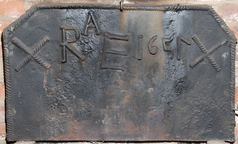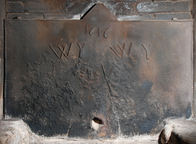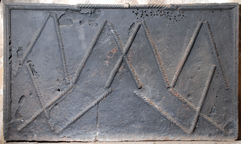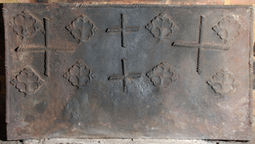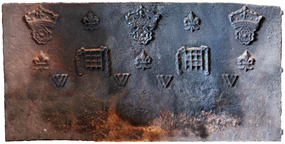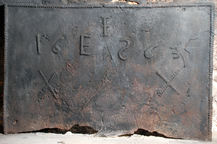-
1047
Description: Sub-rectangular shape, no edging; three impressions formed of a dagger (c.350mm) with fleur-de-lys terminals: two, at each end, with the handle uppermost, the other inverted lower right of centre.
Notes: The dagger (length approx. 39cm) can be described as a 'cross-hilt' or 'quillon' type, possibly of German origin (ex. inf. Tobias Capwell). The grouping of three daggers may also have apotropaic significance in relation to the Trinity. Formerly part of the J. H. Every collection.
- Decoration tags:
- quasi-rectangular (shape)
- none (edging)
- simple stamps
- apotropaic
- objects
Manufactured: in the 16th century in the Weald area of England.
Current location: Anne of Cleves House, Southover High Street, Lewes, East Sussex, England.
Museum number: LH000.920 (part of the Sussex Archaeological Society museum group)
- Attached to series:
- Knife & Dagger stamp firebacks
-
946
Description: Canted rectangle; twisted rope edging (top and sides); initials in triad to left of date (7 reversed), all between two twisted rope saltires.
Notes: The distinctive form of the number '5' has been seen on another fireback indicating a common source.
Inscription: RAE [triad] 1657
- Decoration tags:
- canted rectangular (shape)
- rope (edging)
- simple stamps
- individual letters
- individual numbers
- apotropaic
- text
- objects
Manufactured: in 1657 in the Weald area of England.
Current location: in private hands, Lindfield, West Sussex, England.
- Attached to series:
- Date & initials firebacks
- Rope design firebacks
- Shortened '5' series
-
471
Description: Rectangular with small central triangle on top; twisted rope edging (top and sides) and across base of triangle; top centre, date, centrally positioned above the separated pairs of initials, WY; below and right of centre, rope saltire; bottom centre, a hole apparently puncturing the plate from behind.
Notes: The initials are those of William Yalden (1580-1659), an ironmaster who was active in north-west Sussex and south-west Surrey where this and other similar firebacks have been noted. The saltire is likely to have had an apotropaic purpose. Although undoubtedly connected with the builder of the house wherein it rests, the fireback pre-dates the building, which was erected in 1640.
Inscription: 1616 / WY WY
- Decoration tags:
- rectangular with triangular arch (shape)
- rope (edging)
- simple stamps
- individual letters
- individual numbers
- apotropaic
- text
Manufactured: in 1616 in the Weald area of England.
Current location: in private hands, Lodsworth, West Sussex, England.
- Attached to series:
- William Yalden series
- Date & initials firebacks
-
484
Description: Fragment (right side only); rectangular; twisted rope edging (top and sides); concentrically grooved disc repeated four times in a square arrangement, with a rope cross between (probably mirrored on the missing half).
Notes: It has not been established from what the circular disc stamp has been derived.
- Decoration tags:
- rectangular (shape)
- rope (edging)
- simple stamps
- apotropaic
- objects
Manufactured: in the mid to late 16th century in the Weald area of England.
Current location: in private hands, Hadlow Down, East Sussex, England.
- Attached to series:
- Miscellaneous stamp firebacks
-
485
Description: Rectangular; ovolo moulded edging (top and sides), except for middle section on top, where twisted rope is used; quasi-symmetrical arrangement of twisted rope lengths in two rows of alternate diagonals, crossing in the middle on the top row, and crossing on the outside on the bottom.
Notes: The section of rope edging on the top suggests that an arch had been removed from the base pattern board. The arrangement of rope lengths may have apotropaic significance, the double 'v' alluding to the Virgin Mary.
- Decoration tags:
- rectangular (shape)
- ovolo (edging)
- simple stamps
- apotropaic
- objects
Manufactured: in the mid to late 16th century in the Weald area of England.
Current location: in private hands, Mayfield, East Sussex, England.
- Attached to series:
- Rope design firebacks
-
846
Description: Rectangular; twisted rope edging (top and sides); floriated trefoil stamp repeated in two rows of four in the upper two-thirds of the plate; between the middle four stamps, two small crosses of twisted rope, one above the other; between each outer group of four stamps a large cross of twisted rope.
Notes: The floriated trefoils may have been derived from a metal ornament.
- Decoration tags:
- rectangular (shape)
- rope (edging)
- simple stamps
- apotropaic
- objects
Manufactured: in the mid to late 16th century in the Weald area of England.
Current location: in private hands, Barcombe, East Sussex, England.
- Attached to series:
- Miscellaneous stamp firebacks
- Metalware stamp firebacks
-
1222
Description: Rectangular shape; no edging; symmetrical arrangement of four stamps: across the top, three crowned roses with a fleur-de-lys between each pair; across the middle, three fleurs-de-lys with a chained portcullis between each pair; below and in the spaces between the fleurs and portcullises, four letters W.
Notes: The letter W may have an apotropaic significance; the stamps have not been recorded on other firebacks.
Inscription: W W W W
- Decoration tags:
- rectangular (shape)
- none (edging)
- carved stamps
- heraldic
- apotropaic
- text
- objects
Manufactured: in the late 16th century possibly in the Weald area of England.
Current location: Great Dixter, Northiam, East Sussex, England.
- Attached to series:
- Miscellaneous royal firebacks
-
505
Description: Rectangular; twisted rope edging (top and sides); inscription (‘S’ reversed) across upper middle of plate, with superscripted central ‘I’ (crossed) ; below each part of the date is a twisted rope saltire (145mm lengths).
Notes: A personal fireback, made to order; a similar commission by Giles Moore, Rector of Horsted Keynes, Sussex, in 1657, cost 13 shillings.
Inscription: I / 16 E S 63
- Decoration tags:
- rectangular (shape)
- rope (edging)
- simple stamps
- individual letters
- individual numbers
- apotropaic
- text
- objects
Manufactured: in 1663 in the Weald area of England.
Current location: in private hands, Ockley, Surrey, England.
- Attached to series:
- Date & initials firebacks
-
1141
Description: Arched rectangular shape; twisted rope edging (top and sides); date stamp, 1634, in arch; initials, EH, separated by a cross, below date.
Notes: The same date stamp has been noted on another fireback; the cross between the initials may have an apotropaic purpose.
Inscription: 1634 /E + H
- Decoration tags:
- arched rectangular (shape)
- rope (edging)
- simple stamps
- individual letters
- date stamp
- apotropaic
- text
- objects
Manufactured: in 1634 in England.
Current location: Newark Park, Ozleworth, Gloucestershire, England.
(part of the National Trust museum group)
- Attached to series:
- Date & initials firebacks
- 1634 stamp series
-
1248
Description: Central arched rectangular shape with rounded corners; ovolo moulding all round; oval Tudor royal shield with garter surrounding, topped with a royal crown; dragon and greyhound supporters; initials split by crown; all details below shield illegible; rectangular extension panels on each side, with twisted rope edging; quasi mirrored arrangement of twisted rope lengths to form (from the top) a cross, a vertical pointing arrow, and a diamond shape with a central vertical line.
Notes: The detail of the extension panel is sharper than the armorial, indicating that the panel was cast with a worn copy of the armorial. Illustrated in Weaver, 1914, p. 16.
Inscription: E R [+ Garter, Harvo and royal mottoes, all illegible]
Arms: Tudor royal (prob. Henry VIII)
- Decoration tags:
- arched rectangular with curved shoulders (shape)
- rope and ovolo moulding (edging)
- simple stamps
- whole carved pattern
- extension panels
- heraldic
- apotropaic
- armorial
- royal
- text
- objects
Manufactured: in the late 16th to early 17th century in the Weald area of England.
Current location: in private hands, Plaistow, West Sussex, England.
Citation: Weaver, L., 1914, Small Country Houses: their repair and enlargement (London, Country Life).
- Attached to series:
- Pounsley series
- John Harvo series
- Tudor royal armorial firebacks
